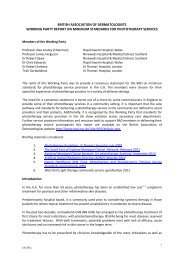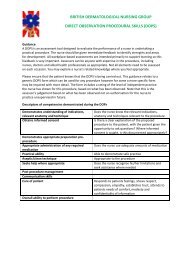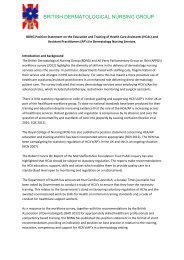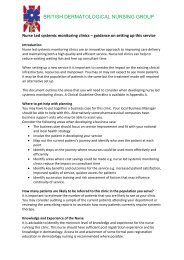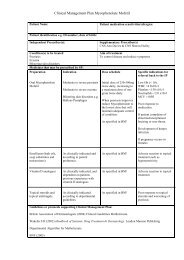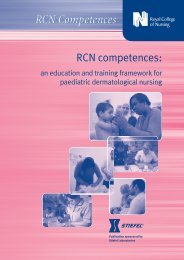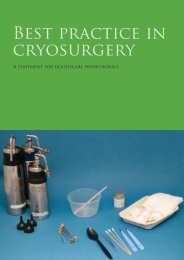Improving outcomes for people with skin tumours including melanoma
Improving outcomes for people with skin tumours including melanoma
Improving outcomes for people with skin tumours including melanoma
Create successful ePaper yourself
Turn your PDF publications into a flip-book with our unique Google optimized e-Paper software.
<strong>Improving</strong> Outcomes <strong>for</strong><br />
People <strong>with</strong> Skin Tumours<br />
<strong>including</strong> Melanoma<br />
Initial investigation,<br />
diagnosis, staging and<br />
management<br />
Isolated limb perfusion (ILP) may be an option <strong>for</strong> selected patients,<br />
especially those at risk of limb loss, <strong>with</strong> remission rates of up to 60%<br />
<strong>for</strong> periods of up to 2 years but <strong>with</strong> a small risk of serious morbidity.<br />
This option should be reserved <strong>for</strong> advanced in-transit disease when<br />
simpler and safer methods have been exhausted. Isolated limb<br />
infusion (ILI) is a relatively new technique that appears to be of equal<br />
efficacy; it is less invasive and easier to repeat, but toxicity is similar<br />
to ILP. Worldwide there is less experience of ILI than of ILP.<br />
Correspondingly, there is less evidence available <strong>for</strong> ILI than <strong>for</strong> ILP.<br />
Both methods are occasionally used to treat other types of <strong>skin</strong><br />
cancers and sarcomas.<br />
4<br />
Non-<strong>melanoma</strong> <strong>skin</strong> cancer<br />
The standard effective treatment is surgical excision and all excised<br />
specimens should be sent <strong>for</strong> histopathological examination.<br />
However, there are a range of other surgical and non-surgical<br />
procedures, which are well described in clinical guidelines. Where the<br />
other non-surgical treatments exclude histological confirmation of the<br />
diagnosis, an incisional biopsy <strong>for</strong> confirmation of the diagnosis<br />
should usually be obtained be<strong>for</strong>e treatment.<br />
Other surgical and non-surgical procedures include:<br />
• Curettage and cautery/electrodesiccation. This technique is<br />
per<strong>for</strong>med using a curette to remove soft material from the<br />
tumour. The base of the tumour is then destroyed, using either<br />
hyfrecation or cautery. This may be used to treat small (less than<br />
1 cm) primary BCCs, in situ SCCs and AKs. It is safe and well<br />
tolerated, and usually produces a good cosmetic outcome. It is<br />
suitable <strong>for</strong> patients <strong>with</strong> multiple lesions. However, the<br />
histology may be difficult to interpret as the lesion may be<br />
incompletely removed and margins of excision cannot be<br />
assessed optimally.<br />
• Cryotherapy/cryosurgery. Cryotherapy is the destruction of<br />
<strong>skin</strong> lesions using liquid nitrogen. It is a cost-effective treatment<br />
and is well established <strong>for</strong> small lesions <strong>including</strong> AK, superficial<br />
BCC and in situ SCC. However, histology is not available unless<br />
an incisional biopsy is taken first.<br />
• Topical treatment. Imiquimod (Aldara 5% cream). This is a<br />
new immune-response-modifying agent that has recently been<br />
licensed <strong>for</strong> the treatment of small superficial BCCs.<br />
Fluorouracil (Efudix 5% cream). This is licensed <strong>for</strong> ‘superficial<br />
malignant and precancerous <strong>skin</strong> lesions’.<br />
82<br />
National Institute <strong>for</strong> Health and Clinical Excellence




